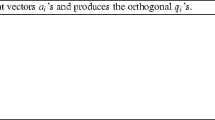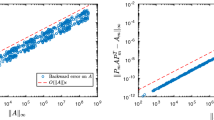Abstract
A reorthogonalized block classical Gram–Schmidt algorithm is proposed that factors a full column rank matrix \(A\) into \(A=QR\) where \(Q\) is left orthogonal (has orthonormal columns) and \(R\) is upper triangular and nonsingular. This block Gram–Schmidt algorithm can be implemented using matrix–matrix operations making it more efficient on modern architectures than orthogonal factorization algorithms based upon matrix-vector operations and purely vector operations. Gram–Schmidt orthogonal factorizations are important in the stable implementation of Krylov space methods such as GMRES and in approaches to modifying orthogonal factorizations when columns and rows are added or deleted from a matrix. With appropriate assumptions about the diagonal blocks of \(R\), the algorithm, when implemented in floating point arithmetic with machine unit \(\varepsilon _M\), produces \(Q\) and \(R\) such that \(\Vert I- Q ^T\!~ Q \Vert =O(\varepsilon _M)\) and \(\Vert A-QR \Vert =O(\varepsilon _M\Vert A \Vert )\). The first of these bounds has not been shown for a block Gram–Schmidt procedure before. As consequence of these results, we provide a different analysis, with a slightly different assumption, that re-establishes a bound of Giraud et al. (Num Math, 101(1):87–100, 2005) for the CGS2 algorithm.
Similar content being viewed by others
References
Abdelmalek, N.I.: Roundoff error analysis for Gram–Schmidt method and solution of linear least squares problems. BIT 11(4), 354–367 (1971)
Barlow, J.L., Smoktunowicz, A., Erbay, H.: Improved Gram–Schmidt downdating methods. BIT 45, 259–285 (2005)
Björck, Å.: Numerics of Gram–Schmidt orthogonalization. Linear Algebra Appl. 197–198, 297–316 (1994)
Björck, Å.: Numerical Methods for Least Squares Problems. SIAM Publications, Philadelphia (1996)
Daniel, J.W., Gragg, W.B., Kaufman, L., Stewart, G.W.: Reorthogonalization and stable algorithms for updating the Gram–Schmidt QR factorization. Math. Comp. 30(136), 772–795 (1976)
Dongarra, J.J., DuCroz, J.J., Duff, I.S., Hammarling, S.J.: A set of level 3 basic linear algebra subprograms. ACM Trans. Math. Softw. 16, 1–17 (1990)
Giraud, L., Langou, J., Rozložnik, M.: Rounding error analysis of the classical Gram–Schmidt orthogonalization process. Numer. Math. 101(1), 87–100 (2005)
Golub, G.H., Van Loan, C.F.: Matrix Computations. The Johns Hopkins Press, Baltimore (1996)
Greenbaum, A., Rozložnik, M., Strakoš, Z.: Numerical behavior of the modified Gram–Schmidt GMRES implementation. BIT 37, 706–719 (1997)
Higham, N.J.: Accuracy and Stability of Numerical Algorithms, 2nd edn. SIAM Publications, Philadelphia (2002)
Hoemmen, M.F.: Communication-avoiding Krylov subspace methods PhD thesis. University of California, Berkeley, CA, USA (2010)
Horn, R.A., Johnson, C.A.: Matrix Analysis. Cambridge University Press, Cambridge (1985)
Jalby, W., Phillippe, B.: Stability analysis and improvement of the block Gram–Schmidt algorithm. SIAM J. Sci. Stat. Comput. 12, 1058–1073 (1991)
Paige, C.C., Rozložnik, M., Strakoš, Z.: Modified Gram–Schmidt (MGS), least squares and the backward stability of MGS-GMRES. SIAM J. Matrix Anal. Appl. 28(1), 264–284 (2006)
Rice, J.R.: Experiments on Gram–Schmidt orthogonalization. Math. Comput. 20(94), 325–328 (1966)
Stathopoulos, A., Wu, K.: A block orthogonalization procedure with constant synchronization requirements. SIAM J. Sci. Comput. 23(6), 2165–2182 (2002)
Stewart, G.W.: Block Gram–Schmidt orthogonalization. SIAM J. Sci. Comput. 31(1), 761–775 (2008)
Vanderstaeten, D.: An accurate parallel block Gram–Schmidt algorithm without reorthogonalization. Numer. Linear Algebra Appl. 7, 219–236 (2000)
Acknowledgments
Ilse Ipsen, Miro Rozložnik, Hasan Erbay and two tenacious referees made helpful suggestions on an earlier version of this manuscript. Rich Lehoucq told the first author about reference [16].
Author information
Authors and Affiliations
Corresponding author
Additional information
The research of J. L. Barlow was sponsored by the National Science Foundation under contract no. CCF-1115704.
Appendix. Proofs of technical lemmas from Sect. 3
Appendix. Proofs of technical lemmas from Sect. 3
Two of the technical lemmas in Sect. 3, Lemmas 3.1 and 3.3 are based upon matrix multiply and add operations, thus those proofs are presented first. The proof of Lemma 3.2 and the proof of Lemma 3.5 are verifications that two norm bounds in exact arithmetic are not significantly altered in floating point arithmetic.
Using a result from Higham [10, p.71] on matrix multiplication in floating point arithmetic and putting in an additional term for a matrix add, the operation
satisfies
where
for some modest constant \(d_{mat}\). If we use the bound on the two-norm
for an \(M \in \mathbb R ^{m \times p}, m \ge p\), then we have
Thus the bound on these operations for Functions 2.1 and 2.2 in Lemmas 3.1 and 3.3 are just a matter of bounding \(\Vert C\Vert \), \(\Vert G\Vert \) and \(\Vert H\Vert \) in the appropriate context.
First, we prove Lemma 3.1 which concerns the operations of the form (6.1) in Function 2.1.
Proof of Lemma 3.1
Interpreting (6.3) for the computation in (3.18), we have
By the assumption (3.15), \(\Vert U\Vert \le c_U(\varepsilon _M) \le \sqrt{2}\), thus
which is the bound in (3.18).
The second such operation is given in (3.19). The interpretation of (6.3) for that computation is
By our assumptions below (3.13),
By (3.15), we have that \(\Vert U\Vert \le \sqrt{2}\), thus
which is the bound in (3.19). \(\square \)
Lemma 3.3 concerns two computations in Function 2.2 that are of the form (6.2).
Proof of Lemma 3.3
Interpreting (6.3) for the computation in (3.32) yields
To bound the norms, we have that
Thus
The final such operation is that in (3.33). The interpretation of (6.3) is
Using the bounds in (3.30)–(3.31), this is
Lemma 3.2, our next technical lemma, is a bound on \(\Vert I_m-UU^T\Vert \) where \(U\in \mathbb R ^{m \times t}\) is near left orthogonal.
Proof of Lemma 3.2
Let \(U\) have the Q-R decomposition
where \(Z\) is orthogonal and \(R_U\) is upper triangular. Then
and
Since \(R_U^T\!~R_U\) and \(R_UR_U^T\) have the same eigenvalues,
Using the assumption (3.15) and the results of Theorem 3.1, we have
by our assumption about \(f_1(m,t,p)\) in (1.4). \(\square \)
Lemma 3.5, our final technical lemma, is a result relating \(\Vert \bar{R}_2^{-1}\Vert \) to \(\Vert U^T \bar{Q}_1 \bar{R}_2^{-1}\Vert \). It has the elementary but long proof given next.
Proof of Lemma 3.5
We start with interpreting Lemma 3.1 for the second CGS step in Function 2.2 which leads to
Taking the normal equations matrices of both sides yields
An expansion of \(\bar{Q}_1^T (I_m-UU^T)^2 \bar{Q}_1\) produces
so that the combination of (6.5) and (6.6) is
where
Standard norm bounds for \(E_1\) and \(E_3\) yields
whereas for \(E_2\) if we use the fact that
then
since \(\gamma (k) \le 1\), \(c_R(\varepsilon _M) \le \sqrt{2}\), and \(c_Q(\varepsilon _M) \le \sqrt{2}\). Thus, using (3.4), we have
Now to show the equivalence between (3.45) and (3.46). Since we assume that \(\bar{R}_2\) is nonsingular, we can rewrite (6.7) as
so that
If \(\lambda _{max}(\cdot )\) is the maximum absolute eigenvalue of the contents, then (6.9) plus Weyl’s inequality for eigenvalues [8, Corollary 8.1.6] and a norm bound yield
where
Using the relationship, \(\lambda _{max}(C^T\!~C)=\Vert C\Vert ^2\) on (6.10) yields (3.44). \(\square \)
Rights and permissions
About this article
Cite this article
Barlow, J.L., Smoktunowicz, A. Reorthogonalized block classical Gram–Schmidt. Numer. Math. 123, 395–423 (2013). https://doi.org/10.1007/s00211-012-0496-2
Received:
Revised:
Published:
Issue Date:
DOI: https://doi.org/10.1007/s00211-012-0496-2




